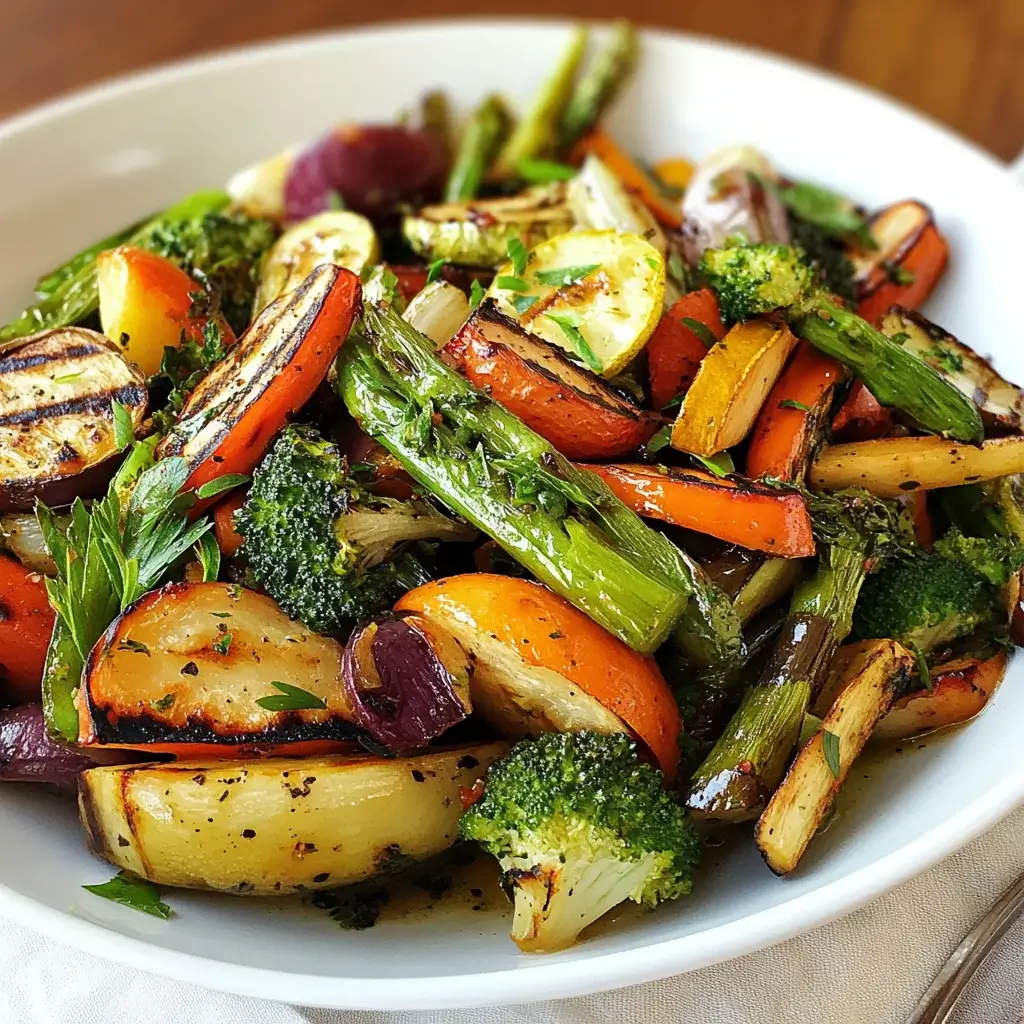Spring has sprung, and with it comes a vibrant bounty of fresh, crisp, and utterly delicious vegetables. For years, my family has eagerly anticipated the arrival of spring, not just for the warmer weather and blooming flowers, but for the incredible flavors that burst from the garden and farmer’s markets. This Spring Veggie Medley recipe has become a staple in our home, a dish that perfectly captures the essence of the season. From the tender asparagus spears to the sweet snap peas and the earthy new potatoes, every bite is a celebration of spring’s renewal. Even my pickiest eaters, who often turn their noses up at vegetables, devour this medley with surprising enthusiasm. The vibrant colors and fresh flavors are just irresistible, making it a side dish that’s not only healthy but genuinely enjoyable for everyone at the table. Whether we’re grilling outdoors, enjoying a cozy weeknight dinner, or hosting a springtime brunch, this Spring Veggie Medley is always a welcome addition, bringing a touch of sunshine and garden-fresh goodness to every meal. It’s simple to prepare, incredibly versatile, and always a crowd-pleaser – a true testament to the magic of seasonal eating.
Ingredients for a Burst of Spring Flavor
This Spring Veggie Medley is all about showcasing the best of the season’s produce. Here’s what you’ll need to create this vibrant and flavorful dish:
- Asparagus: (1 pound, trimmed) – Thin to medium spears are ideal, offering a delicate, slightly grassy flavor and tender texture. Look for bright green stalks with tightly closed tips.
- Snap Peas: (1 pound, strings removed) – These offer a delightful sweetness and satisfying crunch. Choose pods that are plump and brightly colored.
- New Potatoes: (1 pound, halved or quartered if large) – Small, thin-skinned potatoes that are naturally sweet and creamy. Red or Yukon Gold varieties work beautifully.
- Carrots: (1 pound, peeled and sliced into rounds or batons) – Adds sweetness and a vibrant orange hue. Choose firm, smooth carrots for the best flavor and texture.
- Radishes: (1 bunch, trimmed and halved or quartered if large) – Provides a peppery bite and a lovely pink or red color. Look for firm radishes with fresh-looking greens.
- Spring Onions (Scallions): (1 bunch, white and light green parts, chopped) – Offers a milder onion flavor than mature onions, perfect for spring dishes.
- Fresh Lemon: (1, juiced and zested) – Brightens the flavors and adds a zesty tang. Use a fresh lemon for the best aroma and taste.
- Olive Oil: (3 tablespoons) – For roasting the vegetables, adding richness and helping them caramelize. Extra virgin olive oil is recommended for its flavor and health benefits.
- Garlic: (2 cloves, minced) – Enhances the savory notes of the vegetables and adds a delicious aroma.
- Fresh Herbs: (such as thyme, rosemary, parsley, or chives, chopped, about 2 tablespoons total) – Adds a fragrant and fresh dimension to the medley. Choose your favorites or a combination for a complex herbal flavor.
- Salt and Black Pepper: (to taste) – Essential seasonings to enhance all the flavors. Freshly ground black pepper is always preferred.
- Optional: Red Pepper Flakes: (pinch, for a touch of heat) – Adds a subtle warmth to the dish if desired.
Step-by-Step Instructions for Spring Veggie Perfection
Creating this Spring Veggie Medley is surprisingly simple, making it perfect for busy weeknights or elegant gatherings. Follow these easy steps to bring this vibrant dish to life:
- Preheat Your Oven and Prepare a Baking Sheet: Begin by preheating your oven to 400°F (200°C). This high temperature is crucial for roasting the vegetables to perfection, allowing them to caramelize and develop deep, rich flavors. While the oven is preheating, line a large baking sheet with parchment paper. Parchment paper is your best friend for easy cleanup and prevents the vegetables from sticking to the pan. If you don’t have parchment paper, you can lightly grease the baking sheet with olive oil.
- Prepare the Vegetables: Now, it’s time to prepare your beautiful spring vegetables. Start with the new potatoes. Wash them thoroughly and if they are small, you can leave them whole. If they are larger, halve or quarter them so they cook evenly with the other vegetables. Next, trim the woody ends of the asparagus spears, usually the bottom inch or two. Snap peas need minimal prep; simply remove the strings along the sides of the pods. Peel the carrots and slice them into rounds or batons, depending on your preference – rounds are great for even cooking, while batons offer a more elegant presentation. Trim and halve or quarter the radishes, again ensuring they are roughly the same size for even roasting. Finally, chop the white and light green parts of the spring onions (scallions). Mince the garlic cloves finely to release their aromatic oils.
- Toss Vegetables with Olive Oil and Seasonings: In a large bowl, combine all the prepared vegetables: new potatoes, asparagus, snap peas, carrots, radishes, and spring onions. Drizzle the olive oil over the vegetables. Olive oil is essential for roasting as it helps the vegetables to cook evenly, prevents them from drying out, and encourages browning and caramelization. Add the minced garlic, lemon zest, chopped fresh herbs (thyme, rosemary, parsley, or chives – or a mix!), salt, and black pepper. If you like a touch of heat, add a pinch of red pepper flakes. Use your hands or a large spoon to toss everything together thoroughly, ensuring that all the vegetables are evenly coated with the olive oil and seasonings. This step is crucial for flavor distribution and even cooking.
- Arrange Vegetables on the Baking Sheet: Spread the seasoned vegetables in a single layer on the prepared baking sheet. It’s important not to overcrowd the pan, as this can cause the vegetables to steam instead of roast, resulting in a less desirable texture. If your baking sheet is too small, roast the vegetables in two batches. Arranging them in a single layer allows for proper air circulation and ensures that each piece gets beautifully roasted and slightly crispy.
- Roast the Vegetables: Place the baking sheet in the preheated oven and roast for 20-25 minutes, or until the vegetables are tender-crisp and lightly browned. Roasting time can vary depending on the size and density of your vegetables and your oven. Halfway through the roasting time, around 10-12 minutes, gently toss the vegetables with a spatula to ensure even cooking and browning on all sides. Keep an eye on them towards the end of the roasting time to prevent burning, especially the more delicate vegetables like asparagus and snap peas. You want them to be tender but still have a bit of bite – perfectly cooked spring vegetables should retain some of their vibrant color and texture.
- Finish with Lemon Juice and Serve: Once the vegetables are roasted to perfection, remove the baking sheet from the oven. Immediately squeeze fresh lemon juice over the hot vegetables. The lemon juice adds a bright, zesty finish that complements the roasted flavors beautifully and enhances the overall freshness of the dish. Toss gently to distribute the lemon juice evenly. Taste and adjust seasoning if needed, adding more salt, pepper, or lemon juice to your preference. Serve the Spring Veggie Medley immediately while it’s still warm and vibrant. The warmth enhances the flavors and textures, making it the most enjoyable.
Nutrition Facts: Spring Veggie Medley (per serving)
This Spring Veggie Medley is not only delicious but also packed with nutrients, making it a healthy and wholesome side dish. Here’s an approximate nutritional breakdown per serving (based on 6 servings and typical vegetable quantities, values are estimates and can vary):
- Serving Size: Approximately 1 cup
- Calories: 120-150 kcal
- Fat: 8-10g (primarily from olive oil, healthy fats)
- Vitamin C: High (from various vegetables, especially snap peas and radishes)
This medley is also rich in Vitamin A, Vitamin K, folate, and potassium, depending on the specific vegetables used and their proportions. It’s naturally low in cholesterol and sodium (depending on added salt) and provides a good source of antioxidants and phytonutrients from the variety of colorful vegetables. Enjoy this dish as a delicious way to boost your intake of essential vitamins and minerals.
Preparation Time: From Garden to Table in Minutes
This Spring Veggie Medley is designed for ease and speed, perfect for those who want a healthy and flavorful dish without spending hours in the kitchen.
- Prep Time: 15-20 minutes (Includes washing, trimming, and chopping vegetables, mincing garlic, and zesting lemon)
- Cook Time: 20-25 minutes (Roasting time in the oven)
- Total Time: 35-45 minutes (From start to finish, ready to serve)
The majority of the time is hands-off roasting in the oven, allowing you to focus on other tasks or simply relax while the delicious aromas fill your kitchen. This recipe is truly a weeknight winner!
How to Serve Your Vibrant Spring Veggie Medley
This versatile Spring Veggie Medley is a fantastic side dish that complements a wide array of main courses. Its bright flavors and colors make it a welcome addition to any meal. Here are some serving suggestions:
- As a Side Dish:
- Grilled Proteins: Perfect alongside grilled chicken, fish, steak, or tofu. The roasted vegetables provide a healthy and flavorful counterpoint to the richness of grilled meats or plant-based proteins.
- Roasted Chicken or Fish: Serve with roasted chicken thighs, breasts, or a whole roasted chicken. It’s also excellent with baked or pan-seared fish like salmon, cod, or halibut.
- Pasta Dishes: Pairs beautifully with lighter pasta dishes, especially those with lemon or pesto sauces. Toss a spoonful of the medley into pasta for added flavor and nutrients.
- Grain Bowls: Add to quinoa, farro, or rice bowls for a boost of vegetables and flavor. The roasted vegetables provide texture and depth to grain-based meals.
- Quiches and Frittatas: Serve alongside a quiche or frittata for a balanced brunch or light dinner. The medley complements egg-based dishes perfectly.
- Creative Serving Ideas:
- Warm Salad: Toss the roasted vegetables with mixed greens, a light vinaigrette, and crumbled feta or goat cheese for a delicious warm salad.
- Pizza Topping: Use the roasted vegetables as a topping for homemade or store-bought pizza. They add a gourmet touch and fresh flavors.
- Tacos or Wraps: Stuff the medley into tacos or wraps with hummus or a yogurt-based sauce for a vegetarian or vegan meal.
- Omelets or Scrambled Eggs: Incorporate leftover roasted vegetables into omelets or scrambled eggs for a flavorful and nutritious breakfast or brunch.
- Bruschetta Topping: Chop the roasted vegetables and use them as a topping for bruschetta with a drizzle of balsamic glaze.
Additional Tips for Spring Veggie Medley Success
Elevate your Spring Veggie Medley to the next level with these helpful tips and tricks:
- Seasonal Vegetable Swaps: Embrace the seasonality! Feel free to substitute vegetables based on what’s freshest and available. In early spring, consider adding fiddleheads (if you know how to prepare them safely), ramps, or artichoke hearts. Later in spring, you might include green beans, zucchini, or bell peppers. Variety keeps the dish exciting and ensures you’re using the best produce of the season.
- Roasting Vegetables Evenly: Cut vegetables into similar sizes to ensure they cook at the same rate. Denser vegetables like potatoes and carrots may need to be cut smaller than more delicate ones like asparagus and snap peas. This prevents some vegetables from being undercooked while others are overcooked.
- Don’t Overcrowd the Pan: As mentioned earlier, overcrowding the baking sheet leads to steaming rather than roasting. If necessary, use two baking sheets or roast in batches. Proper spacing allows for good air circulation and crispy, caramelized vegetables.
- Enhance Flavor with Herbs and Spices: Experiment with different herbs and spices to customize the flavor profile. Thyme and rosemary are classic choices, but you can also try dill, oregano, or even a touch of smoked paprika for a smoky note. Fresh herbs are best, but dried herbs can be used – just use about half the amount.
- Add a Balsamic Glaze Drizzle: For an extra touch of sweetness and tang, drizzle a balsamic glaze over the roasted vegetables just before serving. The glaze adds a beautiful sheen and complements the savory flavors.
- Make it Ahead (Partially): You can prep the vegetables ahead of time – wash, trim, and chop them and store them in an airtight container in the refrigerator for up to a day. When you’re ready to cook, simply toss them with olive oil and seasonings and roast. This saves time on busy weeknights.
- Grilling Option for Summer: As the weather warms up, consider grilling the vegetables instead of roasting. Toss them with olive oil and seasonings and grill in a grill basket or on skewers until tender-crisp and slightly charred. Grilling adds a wonderful smoky flavor that’s perfect for summer.
- Storage and Reheating: Leftover Spring Veggie Medley can be stored in an airtight container in the refrigerator for up to 3 days. Reheat gently in the oven at 350°F (175°C) or in a skillet over medium heat until warmed through. Microwaving can also be used, but the texture may be slightly softer. The roasted vegetables are delicious cold as well, making them a great addition to salads or lunchboxes.
Frequently Asked Questions (FAQ) about Spring Veggie Medley
Got questions about making the perfect Spring Veggie Medley? Here are answers to some common queries:
Q1: Can I use frozen vegetables in this recipe?
A1: While fresh spring vegetables are ideal for this recipe to capture their vibrant flavors and textures, you can use frozen vegetables in a pinch. If using frozen vegetables, thaw them completely and pat them dry thoroughly before roasting. Frozen vegetables tend to release more moisture, so roasting time might need to be adjusted, and they may not get as crispy as fresh vegetables. Asparagus and peas can be used frozen, but for potatoes and carrots, fresh is highly recommended for best texture.
Q2: How do I prevent my vegetables from becoming soggy when roasted?
A2: The key to preventing soggy roasted vegetables is to ensure they are dry before roasting and to avoid overcrowding the baking sheet. Pat the vegetables dry with paper towels after washing and trimming. Overcrowding steams the vegetables, leading to sogginess. Use a large enough baking sheet or roast in batches to allow for proper air circulation. Also, roasting at a high temperature (400°F/200°C) helps to caramelize the vegetables and prevent them from becoming mushy.
Q3: Can I add protein to this medley to make it a complete meal?
A3: Absolutely! While this recipe is designed as a side dish, you can easily add protein to make it a more substantial meal. Consider adding roasted chickpeas, white beans, or lentils to the baking sheet along with the vegetables. You could also toss in cooked quinoa or farro after roasting. For meat-eaters, grilled chicken or sausage could be served alongside or mixed in after cooking. Tofu or tempeh cubes roasted with the vegetables are excellent vegan protein additions.
Q4: What are good herb substitutions if I don’t have the ones listed?
A4: Don’t worry if you don’t have thyme, rosemary, parsley, or chives on hand. Good substitutes include oregano, dill, basil, or marjoram. You can also use dried herbs if fresh aren’t available, just use about half the amount of dried compared to fresh. Italian seasoning blend or herbes de Provence can also be used for a convenient mix of flavors. Lemon zest and juice are crucial for brightness, so try not to substitute those.
Q5: How long can I store leftover roasted vegetables?
A5: Leftover Spring Veggie Medley can be stored in an airtight container in the refrigerator for up to 3 days. While they are best enjoyed fresh, they can still be delicious the next day or two. The texture might soften slightly upon refrigeration and reheating, but the flavors will still be wonderful.
Q6: Can I freeze this Spring Veggie Medley?
A6: Freezing roasted vegetables is not generally recommended as it can significantly alter their texture, making them mushy upon thawing. The high water content in vegetables can lead to ice crystal formation during freezing, which breaks down the cell structure. It’s best to enjoy this medley fresh or within a few days of roasting.
Q7: Is this recipe vegan and gluten-free?
A7: Yes, this Spring Veggie Medley recipe is naturally both vegan and gluten-free! It is entirely plant-based and does not contain any gluten ingredients. It’s a great option for those with dietary restrictions or preferences.
Q8: Can I make this recipe spicier?
A8: Definitely! If you enjoy a bit of heat, you can easily make this Spring Veggie Medley spicier. Add a generous pinch of red pepper flakes when tossing the vegetables with olive oil and seasonings. You could also include a finely chopped chili pepper, like jalapeño or serrano, or drizzle a hot sauce over the roasted vegetables before serving. Experiment with different levels of spice to find your perfect balance!






